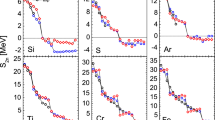Abstract
The existence of Efimov states in atomic nuclei has been predicted by several authors considering 3-body systems of the form Core–neutron–neutron. While these states appear elusive and very challenging experimentally, we discuss possible reactions that can be used to produce and study them in exotic (weakly-bound) nuclei. Following simple arguments, we show that cross-sections relative to the ground states should scale with the parameter \({\lambda_0}\), which is the same scale factor for binding energies and radii. We derive back of the envelope estimates for: one- and two-neutron transfer reactions, and inelastic scattering. The (d, p) reaction appears as the most promising approach and we discuss in more detail some experimental considerations using the example of \({^{19}C(d, p)^{20}C}\). These initial estimates could serve as a starting point for more refined and realistic calculations, which will be required for careful experimental planning and further analysis.
Similar content being viewed by others
References
Frederico T., Delfino A., Tomio L., Yamashita M.: Universal aspects of light halo nuclei. Prog. Part. Nucl. Phys. 67, 939 (2012)
Tanihata I., Savajols H., Kanungo R.: Recent experimental progress in nuclear halo structure studies. Prog. Part. Nucl. Phys. 68, 215 (2012)
Zinner N.T., Jensen A.S.: Comparing and contrasting nuclei and cold atomic gases. J. Phys. G Nucl. Part. Phys. 40, 053101 (2013)
Canham D., Hammer H-W.: Universal properties and structure of halo nuclei. EPJA 37, 367 (2008)
Greene, C.: Universal insights from few-body land. Phys. Today, 63, 40–45 (2010)
Efimov V.: Energy levels arising from resonant two-body forces in a three-body system. Phys. Lett. B 33, 563 (1970)
Kraemer T. et al.: Evidence for efimov quantum states in an ultracold Gas of caesium atoms. Nature 440, 315 (2006)
Fedorov D.V., Jensen A.S., Riisager K.: Efimov states in halo nuclei. Phys. Rev. Lett. 73, 2817 (1994)
Mazumdar I., Arora, Bhasin V.S.: Three-body analysis of the occurrence of efimov states in 2n halo nuclei such as \({^{19}}\)B, \({^{22}}\)C, and \({^{20}}\)C. Phys. Rev. C 61, 051303 (2000)
Amorim A., Frederico T., Tomio L.: Universal aspects of efimov states and light halo nuclei. Phys. Rev. C 56, R2378 (1997)
Yamashita, M.T., Frederico, T., Hussein, M.S.: A doorway to borromean halo nuclei: the samba configuration. Mod. Phys. Lett. A 21, 1749 [arXiv:nucl-th/0501052] (2006)
Hagen G., Hagen P., Hammer H.W., Platter L.: Efimov physics around the neutron-rich \({^{60}}\)C isotope. Phys. Rev. Lett. 111, 132501 (2013)
Mazumdar I., Rau A.R.P., Bhasin V.S.: Efimov states and their fano resonances in a neutron-rich nucleus. Phys. Rev. Lett. 97, 062503 (2006)
Yamashita M.T., Frederico T., Tomio L.: Trajectory of neutron–neutron–\({^{18}}\)C excited three-body state. Phys. Lett. B 660, 339 (2008)
Glendenning, N.: Direct nuclear reactions. Academic Press, New York (1983) (Reprinted by World Scientific Press), and references therein
Kunz, P.D.: DWUCK4 Program Manual. University of Colorado. http://spot.colorado.edu/~kunz/DWBA.html
Gade A. et al.: Reduction of spectroscopic strength: weakly-bound and strongly-bound single-particle states studied using one-nucleon knockout reactions. Phys. Rev. C 77, 044306 (2008)
Macchiavelli, A.O. et al.: NSCL/ReA3 Letter of Intent 14072 (2014)
Facility for Rare Isotopes Beams, Michigan State University, http://www.frib.msu.edu
Susuki D. et al.: Prototype AT-TPC: toward a new generation active target time projection chamber for radioactive beam experiments. NIM A 691, 39 (2012)
Demonchy C.E., Mittig W. et al.: MAYA: an active-target detector for binary reactions with exotic beams. NIM A 537, 145 (2007)
Macchiaveli, A.O. et al.: Phenomenological analysis of B(E2) transition strengths in neutron-rich carbon isotopes. Phys. Rev. C 90, 67305, and references therein (2014)
Otsuka T. et al.: Novel features of nuclear forces and shell evolution in exotic nuclei. Phys. Rev. Lett. 105, 032501 (2010)
Holt J. et al.: Three-body forces and shell structure in calcium isotopes. J. Phys. G Nucl. Part. Phys. 39, 085111 (2012)
Author information
Authors and Affiliations
Corresponding author
Rights and permissions
About this article
Cite this article
Macchiavelli, A.O. How to Study Efimov States in Exotic Nuclei?. Few-Body Syst 56, 773–778 (2015). https://doi.org/10.1007/s00601-015-0998-4
Received:
Accepted:
Published:
Issue Date:
DOI: https://doi.org/10.1007/s00601-015-0998-4




